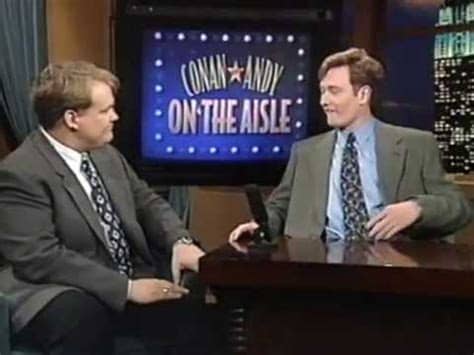Conan O’Brien and Andy Richter are talk show mainstays now, with Conan hosting some incarnation of his show for nearly 28 years, the majority of them with Richter in the sidekick role. The late night format is in a long decline from its heyday, and after ten years on TBS and almost a decade of watered-down NBC versions in the 2000s (including the infamous moment when their rightful inheritance of The Tonight Show was yanked away), it’s a little tough to remember the bizarre mini-revelation of the early incarnation of Late Night with Conan O’Brien.
You see, kids, in ye olden days of the 90s if you wanted to watch television you had to watch what the stations put on for you. And after dark, they stopped showing things except maybe some infomercials hosted by a bevy of hyperactive and disturbing pitchmen. The attitude of Late Night in its early days seemed to be “nobody’s watching anyway.”
This was apparent in its booking of b- and c-list celebrities for interviews and sometimes outright stated (an early anniversary episode had congratulation videos from the show’s main competitors: interviewer Tom Snyder and a test pattern). But the devil-may-care attitude was most evident in the nightly surrealism the show inherited from previous host David Letterman and run through the sensibilities of early writers like Robert Smigel, Bob Odenkirk, Dino Stamatopoulos and Richter and O’Brien themselves. The result was recurring lo-fi segments like “In the Year 2000” and “Conan and Andy On the Aisle” (called simply “Conan on the Aisle” for the years Andy had left the show).
The segment posed Conan and Andy as occasional film reviewers in the Siskel & Ebert or Gene Shalit mode. They would discuss a current release and praise the film – but always complain that something about the movie was amiss before introducing a clip. The clip, swiped from the press kit scenes sent around to every talk with show to play alongside interviews with the stars, plays normally for a while – sometimes a couple minutes or more – before the punchline arrives in the form of one or more shots looped, new shots inserted, absurd audio dubbed and/or digitally added actors and elements.
The digital effects were some of the early adopters of what I’d like to call the “funcanny valley,” effects that deliberately draw attention to themselves, with their noticeable seams are part of the joke. The Lonely Island would later perfect this technique and update it as video altering software got cheaper and more accessible.
The goofy morsels fit right for a kid up past his bedtime who loved movies and silly comedy. The skits were something of a missing link between MAD magazine and Mystery Science Theater 3000 (which was one of your other late night options on the right night and if you had cable).
Eventually Late Night got too big to pass under the radar and with the arrival of higher profile celebrity interviews (and their managers) came a tightening of the reins. Gone was the possibility of, say, a guest getting their time usurped by Norm MacDonald during an interview or an ongoing feud with Jennifer Lopez (which he tried to soothe with an offer to be second guest after Dateline anchor Stone Phillips). Luckily the goofiness of the show entered the mainstream and “Conan and Andy On the Aisle” stayed as part of the regular rotation of skits.

